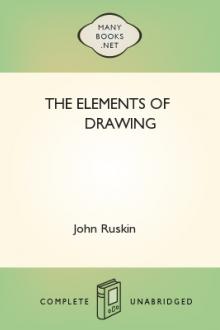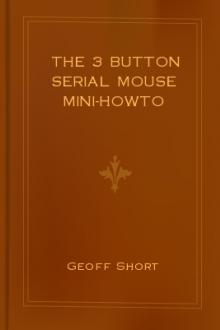The Elements of Drawing by John Ruskin (acx book reading .TXT) 📖

- Author: John Ruskin
- Performer: -
Book online «The Elements of Drawing by John Ruskin (acx book reading .TXT) 📖». Author John Ruskin
Village churches in England are not often good subjects; there is a peculiar meanness about most of them and awkwardness of line. Old manor-houses are often pretty. Ruins are usually, with us, too prim, and cathedrals too orderly. I do not think there is a single cathedral in England from which it is possible to obtain one subject for an impressive drawing. There is always some discordant civility, or jarring vergerism about them.
125. If you live in a mountain or hill country, your only danger is redundance of subject. Be resolved, in the first place, to draw a piece of rounded rock, with its variegated lichens, quite rightly, getting its complete roundings, and all the patterns of the lichen in true local color. Till you can do this, it is of no use your thinking of sketching among hills; but when once you have done this, the forms of distant hills will be comparatively easy.
126. When you have practiced for a little time from such of these subjects as may be accessible to you, you will certainly find difficulties arising which will make you wish more than ever for a master's help: these difficulties will vary according to the character of your own mind (one question occurring to one person, and one to another), so that it is impossible to anticipate them all; and it would make this too large a book if I answered all that I can anticipate; you must be content to work on, in good hope that Nature will, in her own time, interpret to you much for herself; that farther experience on your own part will make some difficulties disappear; and that others will be removed by the occasional observation of such artists' work as may come in your way. Nevertheless, I will not close this letter without a few general remarks, such as may be useful to you after you are somewhat advanced in power; and these remarks may, I think, be conveniently arranged under three heads, having reference to the drawing of vegetation, water, and skies.
127. And, first, of vegetation. You may think, perhaps, we have said enough about trees already; yet if you have done as you were bid, and tried to draw them frequently enough, and carefully enough, you will be ready by this time to hear a little more of them. You will also recollect that we left our question, respecting the mode of expressing intricacy of leafage, partly unsettled in the first letter. I left it so because I wanted you to learn the real structure of leaves, by drawing them for yourself, before I troubled you with the most subtle considerations as to method in drawing them. And by this time, I imagine, you must have found out two principal things, universal facts, about leaves; namely, that they always, in the main tendencies of their lines, indicate a beautiful divergence of growth, according to the law of radiation, already referred to;[29] and the second, that this divergence is never formal, but carried out with endless variety of individual line. I must now press both these facts on your attention a little farther.
128. You may, perhaps, have been surprised that I have not yet spoken of the works of J. D. Harding, especially if you happen to have met with the passages referring to them in Modern Painters, in which they are highly praised. They are deservedly praised, for they are the only works by a modern[30] draughtsman which express in any wise the energy of trees, and the laws of growth, of which we have been speaking. There are no lithographic sketches which, for truth of general character, obtained with little cost of time, at all rival Harding's. Calame, Robert, and the other lithographic landscape sketchers are altogether inferior in power, though sometimes a little deeper in meaning. But you must not take even Harding for a model, though you may use his works for occasional reference; and if you can afford to buy his Lessons on Trees,[31] it will be serviceable to you in various ways, and will at present help me to explain the point under consideration. And it is well that I should illustrate this point by reference to Harding's works, because their great influence on young students renders it desirable that their real character should be thoroughly understood.
129. You will find, first, in the titlepage of the Lessons on Trees, a pretty wood-cut, in which the tree stems are drawn with great truth, and in a very interesting arrangement of lines. Plate 1 is not quite worthy of Mr. Harding, tending too much to make his pupil, at starting, think everything depends on black dots; still, the main lines are good, and very characteristic of tree growth. Then, in Plate 2, we come to the point at issue. The first examples in that plate are given to the pupil that he may practice from them till his hand gets into the habit of arranging lines freely in a similar manner; and they are stated by Mr. Harding to be universal in application; "all outlines expressive of foliage," he says, "are but modifications of them." They consist of groups of lines, more or less resembling our Fig. 23 below; and the characters especially insisted upon are, that they "tend at their inner ends to a common center;" that "their ends terminate in [are inclosed by] ovoid curves;" and that "the outer ends are most emphatic."
Fig. 23. Fig. 23.130. Now, as thus expressive of the great laws of radiation and inclosure, the main principle of this method of execution confirms, in a very interesting way, our conclusions respecting foliage composition. The reason of the last rule, that the outer end of the line is to be most emphatic, does not indeed at first appear; for the line at one end of a natural leaf is not more emphatic than the line at the other: but ultimately, in Harding's method, this darker part of the touch stands more or less for the shade at the outer extremity of the leaf mass; and, as Harding uses these touches, they express as much of tree character as any mere habit of touch can express. But, unfortunately, there is another law of tree growth, quite as fixed as the law of radiation, which this and all other conventional modes of execution wholly lose sight of. This second law is, that the radiating tendency shall be carried out only as a ruling spirit in reconcilement with perpetual individual caprice on the part of the separate leaves. So that the moment a touch is monotonous, it must be also false, the liberty of the leaf individually being just as essential a truth, as its unity of growth with its companions in the radiating group.
131. It does not matter how small or apparently symmetrical the cluster may be, nor how large or vague. You can hardly have a more formal one than b in Fig. 9, p. 47, nor a less formal one than this shoot of Spanish chestnut, shedding its leaves, Fig. 24; but in either of them, even the general reader, unpracticed in any of the previously recommended exercises, must see that there are wandering lines mixed with the radiating ones, and radiating lines with the wild ones: and if he takes the pen, and tries to copy either of these examples, he will find that neither play of hand to left nor to right, neither a free touch nor a firm touch, nor any learnable or describable touch whatsoever, will enable him to produce, currently, a resemblance of it; but that he must either draw it slowly or give it up. And (which makes the matter worse still) though gathering the bough, and putting it close to you, or seeing a piece of near foliage against the sky, you may draw the entire outline of the leaves, yet if the spray has light upon it, and is ever so little a way off, you will miss, as we have seen, a point of a leaf here, and an edge there; some of the surfaces will be confused by glitter, and some spotted with shade; and if you look carefully through this confusion for the edges or dark stems which you really can see and put only those down, the result will be neither like Fig. 9 nor Fig. 24, but such an interrupted and puzzling piece of work as Fig. 25.[32]
Fig. 24. Fig. 24. Fig. 25. Fig. 25.132. Now, it is in the perfect acknowledgment and expression of these three laws that all good drawing of landscape consists. There is, first, the organic unity; the law, whether of radiation, or parallelism, or concurrent action, which rules the masses of herbs and trees, of rocks, and clouds, and waves; secondly, the individual liberty of the members subjected to these laws of unity; and, lastly, the mystery under which the separate character of each is more or less concealed.
I say, first, there must be observance of the ruling organic law. This is the first distinction between good artists and bad artists. Your common sketcher or bad painter puts his leaves on the trees as if they were moss tied to sticks; he cannot see the lines of action or growth; he scatters the shapeless clouds over his sky, not perceiving the sweeps of associated curves which the real clouds are following as they fly; and he breaks his mountain side into rugged fragments, wholly unconscious of the lines of force with which the real rocks have risen, or of the lines of couch in which they repose. On the contrary, it is the main delight of the great draughtsman to trace these laws of government; and his tendency to error is always in the exaggeration of their authority rather than in its denial.
133. Secondly, I say, we have to show the individual character and liberty of the separate leaves, clouds, or rocks. And herein the great masters separate themselves finally from the inferior ones; for if the men of inferior genius ever express law at all, it is by the sacrifice of individuality. Thus, Salvator Rosa has great perception of the sweep of foliage and rolling of clouds, but never draws a single leaflet or mist wreath accurately. Similarly, Gainsborough, in his landscape, has great feeling for masses of form and harmony of color; but in the detail gives nothing but meaningless touches; not even so much as the species of tree, much less the variety of its leafage, being ever discernible. Now, although both these expressions of government and individuality are essential to masterly work, the individuality is the more essential, and the more difficult of attainment; and, therefore, that attainment separates the great masters finally from the inferior ones. It is the more essential, because, in these matters of beautiful arrangement in visible things, the same rules hold that hold in moral things. It is a lamentable and unnatural thing to see a number of men subject to no government, actuated by no ruling principle, and associated by no common affection: but it would be a more lamentable thing still, were it possible, to see a number of men so oppressed into assimilation as to have no more any individual hope or character, no differences in aim, no dissimilarities of passion, no irregularities of judgment; a society in which no man could help another, since none would be feebler than himself; no man admire another, since none would be stronger





Comments (0)